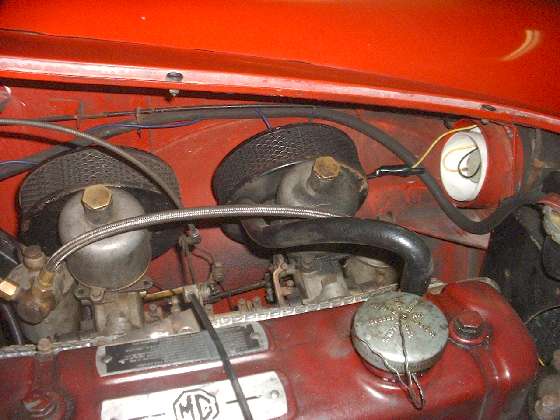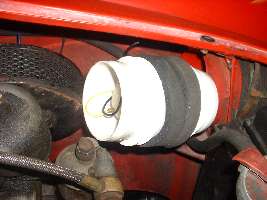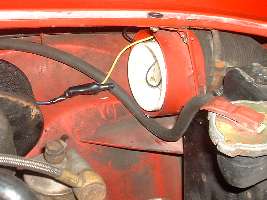The MGA With An Attitude
BILGE BLOWER To Cool Carburetors, 3-inch, #2 -- CB-208B
After having recommended this to others, I finally decided I should try it on my own car. The Attwood 3000 Turbo blower came from Wal-Mart on-line for $22.22 including sales tax and delivery. It was a simple matter to cut off the mounting legs, wrap some 1/2-inch thick rubber weather strip around the center, and stuff it into the left side air duct where is will blow cool air on the carburetors. Electrical connection is temporary for the test run.

I have already decided it is a keeper, and I will ultimately push it farther down the air duct out of site, but for now it sits where it can be seen for inspection (and I can pull it out and put it back in 10 seconds).


An early observation, in a quiet closed garage with engine off, is that the blower makes about the right whining noise that I expected, not as quiet as a squirrel cage fan, but with bonnet closed and engine running, not terribly objectionable (for what it is expected to do).
Next observation is, the thing transmits an audible vibration through the body shell that is noticeable in the cockpit (and anywhere around the car). It sounds very much like a 60-cycle electrical hum from a transformer, and fairly loud. I was somewhat displeased with this feature. I may try relocating the blower a little farther forward where it will be supported inside of the flexible duct with no direct contact to the metal car body.
On 5 July 2012 I got a chance for a good test on a hot day. Notice first that my MGA has a modern VT radiator core with lots of water tubes and closely spaced fins. It can cool well with lots of forced air flow. It can also obstruct air flow when there is not enough forced air, which is common for the MGA in otherwise stock form. Furthermore, my radiator is loaded with dirt and bugs, which I have been intentionally saving for a good hot weather test (too lazy to clean it). All three 4-inch air duct hoses are in place as well as the felt pad under bonnet on top of radiator to eliminate forward flow of hot air, and there is a fan shroud in place. It will not peg the temperature gauge under normal driving conditions. It will not peg the gauge with 2000 rpm idle and a fan shroud. It will peg the temperature gauge on a hot day with a hot engine and standing still with a slow idle speed (900 rpm). This is strictly a matter of not moving much air at low idle speed. I also run 50/50 coolant mix with 7-psi pressure cap, so I can peg the temperature gauge without boiling. This is an intentional condition for raising the coolant temperature for this test. As an additional point of interest, a year earlier I installed an improved heat shield for the carburetor which seems to help but does not eliminate the vapor lock issue in very hot slow driving.
I have installed the Attwood Turbo 3000 3-inch blower (with manual switch) inside the metal air vent pipe ahead of the carburetors. I recon the blower will produce plenty of air flow (excess flow even) for the intended purpose, so I have not bothered with heavy gauge wire or a relay (hate relays where not required). This entire test was done without opening the bonnet, so I have no measurement of carburetor temperature (yet).
At beginning of test ambient air temperature was 102dF (39dC) in the shade (and climbing), and the car was always in full sun in early afternoon. I took a 10-minute drive to get the engine up to full operating temperature, then parked it on hot cement a few feet in front of my garage door to reduce effects of ambient breeze (of which there was very little regardless). As the car sat idling the temperature gauge was steadily rising, as intended. Following is a time log and notes for the testing.
Coolant
Time Temperature Notes
1:40pm 215dF 900 rpm smooth idle
1:43 220dF 900 rpm smooth idle
1:46 225dF 700 rpm slightly rough idle.
Pull choke slightly to restore 900 rpm smooth idle.
1:49 230dF 700 rpm and rough idle, stuttering.
Pull choke more to restore 900 rpm idle, slight stutter.
1:52 235dF (estimated), 700 rpm, bad stuttering,
More choke, now on fuel enrichment 1000 rpm,
somewhat rough idle.
1:54 Getting rougher to idle.
More choke, more fuel 1200 rpm.
1:57 100-psi temperature reading (close to 240dF estimated)
Very rough running at 1000 rpm
1:58:30 Switch on blower.
1:59 Seems a little smoother after only 30 seconds of blower.
1:59:30 Definitely improved running.
2:00 Choke full in, running well.
2:00:30 98-psi 900 rpm smooth idle.
2:02:30 95-psi temperature indication, still climbing slowly.
Push idle to 2000 rpm, no choke.
2:04 100-psi Temperature dropping with high idle speed.
Reduce idle to 900rpm
2:10 85-psi temperature rising again at slow idle
2:12 82-psi 900 rpm smooth idle. Time for a test drive.
25-30 mph 2nd gear for 30 seconds
2:13 90-psi Fairly quick temperature drop with driving.
Drive 40-45 mph 4th gear.
2:16 230dF
2:18 220dF Begin long traffic light stop at slow idle.
2:22 230dF Turn onto expressway, 65-70 mph.
2:28 225dF Temperature dropping slowly at expressway speed.
Exit expressway.
2:29 220dF 900 rpm. Dropped 10dF in 7-miles, 7-minutes.
Long wait at traffic light.
2:30 230dF 900 rpm.
2:32 235dF Turn onto local street 35-40 mph.
2:42 225dF Home, sitting, idling 800 rpm.
2:43 230dF 800 rpm
2:44 235dF 800 rpm
2:45 100-psi 800 rpm
2:46 95-psi (temperature rising)
2:47 90-psi 800 rpm, Ambient temperature 104dF (40dC)
2:49 85-psi
2:51 82-psi 800 rpm still smooth idle
2:52 82-psi Mechanical limit of the temperature gauge.
This is where I would start to worry, because cannot
tell how much hotter it is getting.
Run it into the garage, switch off engine,
switch off blower.
This is when to expect 10-15dF temperature rise
after shut-down.
2:54 82-psi Getting warm in what was a cool garage.
3:06 82-psi
3:07 85-psi Finally dropping after 15 minutes.
3:10 95-psi
3:13 100-psi
3:17 230dF
3:23 220dF
3:30 210dF
3:39 200dF
5:30pm 160dF close garage. End of test.
Observations:
Slightly rough idle commenced at 225dF. It may have happen a little earlier before I installed the improved heat shield. At 230-235 without blower it needs fuel enrichment to run well. This is when the 10% ethanol/gasoline fuel is bubbling in the throttle body (and possibly in the float chamber as well). When temperature needle points to 100 psi in the oil pressure range, it requires half choke to introduce enough fuel to make up for the bubbles, meaning the fuel is boiling with vigor.
When the blower is switched on, there is a bit of improvement within 30 seconds, a lot of improvement within 60 seconds allowing complete release of the choke, and within 90 seconds it is back to very smooth running at normal idle speed. All the while the coolant temperature kept rising, as long as idle speed was kept below 1000 rpm. Beyond that, as long as the blower is running there seems to be nothing that will mess up the carburetors, which was the primary objective for the blower installation.
I don't know what the coolant temperature is when the gauge is pointing at 82-psi in the oil pressure range, mechanical limit of the temperature needle. We know the temperature at the sensor will rise 10-15dF after engine shutdown, but even then the coolant did not boil, not the slightest hint of percolating. The carburetors will of course cook and bubble after shut down if the blower is not running. I don't think it matters much any more, because within one minute of blower switch on the carburetors should be cool enough for easy starting and smooth running. I may do more testing when I can find my infrared thermometer to measure carburetor temperatures.
As to blower noise, it bothered me a little when running the blower in a quiet garage with engine off. When engine running outdoors, the blower noise is similar to the electric fan in any new car, noticeable but not particularly loud or irritating. If you put your face by the grill directly in front of the air inlet duct, the turbine type noise is louder, but just stand up or take one step to the side and the noise is much less. It is a welcome sound considering the job it does. When driving the blower sound may seem like "white noise" and blend into the background so you hardly notice it. It is not at all like the loud turbine type whine I was expecting.
On the question of air flow direction and velocity, the blower output end is pointed in the direction of the air cleaners. However, air from the blower is pressurized slightly, perhaps to higher pressure than air coming off the cooling fan. So as air emerges from the blower (or air duct) the air stream must slow down and expand some, possibly excluding much of the warm radiator air from this space. I imagine that the blower air may fill much of the space around the carburetors between the heat shield and inner fender as it loses velocity, so the carburetors may be surrounded by relatively cool air flow. It may be interesting to do some actual temperature measurements in this space and on the carburetors with and without the blower running. [The following pages include some temperature measurements around the carburetors].
Addendum:
I took the MGA to Road America for the vintage races on July 15 when it hit 100dF by late afternoon. I picked up a friend downtown Chicago in the morning, and dropped him off again in the evening. On the way back from the track we got stuffed by the Sunday evening traffic returning from Wisconsin weekend, resulting in a long stop and stop drag on the Edens expressway. Ambient temperature was about 100dF, and air temperature between the cars and just above the sun-baked pavement was significantly hotter. When the carburetors began to suffer I switched on the bilge blower, and within 60 seconds the engine was purring smooth as a kitten with 800 rpm idle. When coolant temperature was approaching 230dF I increased idle speed to 1500-2000 rpm, and coolant temperature soon dropped back to 220dF. The time spent in the heat and bad traffic conditions was much more tolerable with the blower, almost pleasant (except for the heat affect on the passengers). I suppose this one incident alone is justification for installing the blower.
A couple pages farther on Steve Gyles reports finding a difference in temperature of the float chambers if he can redirect air flow a little bit inboard to blow more onto the float chambers and throttle bodies. I have found that this little blower moves enough air to have wonderful cooling effect on the carburetors, completely eliminating the boiling fuel vapor problems. As long as the hot fuel issues are banished, I suppose it makes no difference where the air flow may be redirected. Apparently it is good enough. Additional fiddling to redirect air flow may lower the float bowl temperature a little, but so far the redirected flow doesn't seem to have any additional beneficial effect on the way it runs.
|